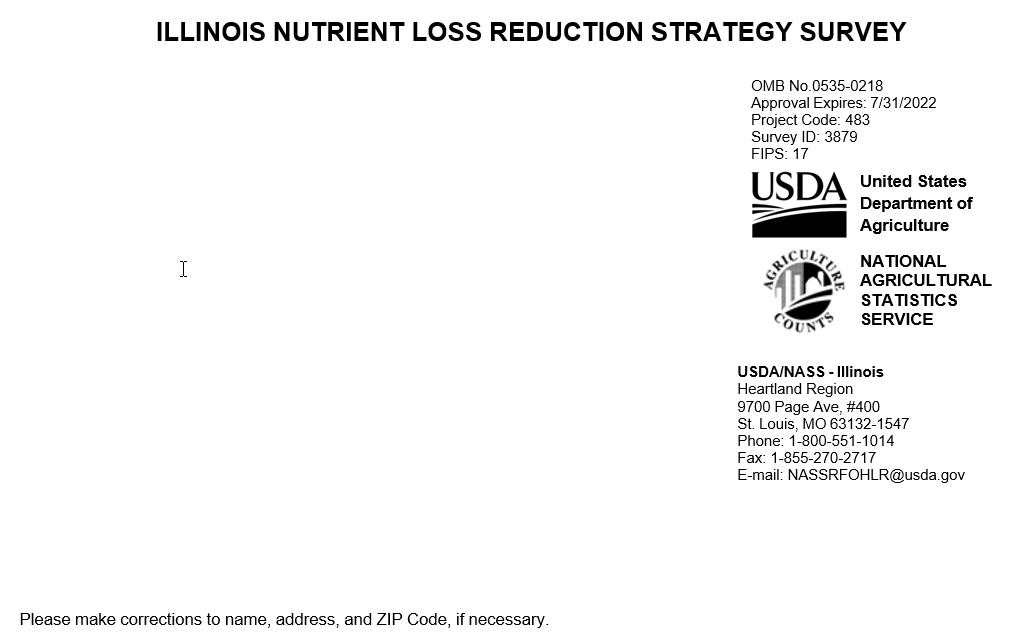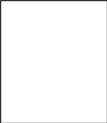QID Illinois Nutrient Loss Reduction Strategy Survey
Agricultural Resource Management and Chemical Use Surveys
0218 - Illinois Nutrient Loss Reduction Strategy Survey - 2021
Agricultural Resource Management, Chemical Use, and Contractor Expense Surveys
OMB: 0535-0218

The information you provide will be used for statistical purposes only. Your responses will be kept confidential and any person who willfully discloses ANY identifiable information about you or your operation is subject to a jail term, a fine, or both. This survey is conducted in accordance with the Confidential Information Protection and Statistical Efficiency Act of 2018, Title III of Pub. L. No. 115-435, codified in 44 U.S.C. Ch. 35 and other applicable Federal laws. For more information on how we protect your information please visit: https://www.nass.usda.gov/confidentiality. Response is voluntary.
According to the Paperwork Reduction Act of 1995, an agency may not conduct or sponsor, and a person is not required to respond to a collection of information unless it displays a valid OMB control number. The valid OMB number is 0535-0218. The time required to complete this information collection is estimated to average 15 minutes per response, including the time for reviewing instructions, searching existing data sources, gathering and
maintaining the data needed, and completing and reviewing the collection of information.
SECTION 1 - CROPLAND ACRES
Please report your total cropland acres on all the land you operated in 2021. Also, provide a breakdown of acres with tiling and without tiling. NOTE: TILE DRAINED acres refers to acres drained by clay tiles, perforated plastic pipes, and pattern tile systems
Please report your operations total cropland acres on all the land you operated including a breakdown of acres with tile drained and non-tile drained in 2021.
Note: TILE DRAINED acres refers to acres drained by clay tiles, perforated plastic pipes, and pattern tile systems.
Of all land operated in 2021, how many acres were … |
Tiled |
Non-tiled |
Total (Tiled + Non-tiled) |
Acres planted to corn |
xxx |
xxx |
xxx |
Acres planted to soybeans |
xxx |
xxx |
xxx |
Other acres of cropland |
xxx |
xxx |
xxx |
Total Cropland |
105 |
106 |
104 |
SECTION 2 - NITROGEN MANAGEMENT
Please consider your nutrient applications in preparation for the 2021 crop season. Review the enclosed map of Illinois and the table of Nitrogen application rates. Our goal is to gather the number of CORN acres you fertilized AT OR BELOW the MRTN rate for your area.
2021
ACRES
xxx
Consider your total CORN acres in 2021 and all of the nitrogen applications to those acres:
On how many CORN acres did your operation use the University of Illinois Recommended total Nitrogen rate (also known as Maximum Return to Nitrogen – MRTN) OR LESS than that rate. (refer to attached map and chart)?.........................................................................
What influenced your decision in determining your total Nitrogen rate (e.g. fertilizer provider, crop consultant, farm management software, etc.). List all that apply...............................................................................................................
_________________________________________
_________________________________________
_________________________________________
Of the total CORN ACRES in 2021, please record the acres fertilized with the strategies listed below. EXCLUDE manure applications.
Please consider all the acres of CORN you planted in 2021, and all the fertilizer you applied for that crop.
|
Corn Acres |
|
xxx |
|
xxx |
a. Of those acres fertilized with Anhydrous Ammonia in the fall, on how many acres did you fertilize using a nitrification or inhibitor? |
xxx |
|
xxx |
|
xxx |
|
xxx |
SECTION 3 - PHOSPHORUS APPLICATIONS and REASONS for REDUCING
Did your operation reduce PHOSPHORUS applications since 2011?

 1 Yes
-
Continue 3 No
-
Go to
Section
4
1 Yes
-
Continue 3 No
-
Go to
Section
4
ACRES
xxx
What influenced your operations decision in reducing phosphorus applications:
The Illinois Agronomy Handbook removal rates for phosphorus were updated in 2017?
701


On how many acres did your operation reduce phosphorus applications because of the Illinois
Agronomy Handbook?......................................
Soil test Information?
702


On how many acres did your operation reduce phosphorus applications because of soil test results?....................................
Other reasons, including cost: Please list below.
710
ACRES

703
If other reasons, On how many acres did your operation reduce phosphorus applications?...........

ACRES
Has your operation changed the placement of phosphorus to move from broadcast to subsurface application or banding application?.........................................................
Yes - Continue No - Go to Section 4

On how many acres did your operation change placement of phosphorus from broadcast to subsurface or banding?
SECTION 4 – COVER CROPS
COVER CROPS refers to crops including grasses, legumes and forbs planted for conservation purposes, including erosion control, improving soil structure, moisture, and nutrient content, increasing beneficial soil biota, or providing habitat for inspects, pollinators and wildlife.
|
xxx |
|
xxx |
|
xxx |
SECTION 5 - GENERAL KNOWLEDGE
For these next questions please enter the code that best describes your operation’s level of knowledge.

517
506
508
518
519
xxx
Total Acres
How many of those acres did you fertilize using a Nitrification Inhibitor?
How many acres were fertilized with Nitrogen during the spring of 2021?
How many of those acres did you fertilize using a Nitrification Inhibitor?
What is your operations level of knowledge of: ENTER CODE

1 - Not at all knowledgeable 2 - Slightly knowledgeable
3 - Somewhat knowledgeable 4 - Knowledgeable
5 - Very knowledgeable
The Illinois Nutrient Loss Reduction Strategy?...................
Maximum Return to Nitrogen (MRTN) strategy?................
c. Wood chip bioreactors?......................................................
d. Constructed Wetlands?......................................................
e. Cover crop management (species selection, planting dates, termination strategy, etc.)?...........................................
f. Saturated buffers?.......................................................
...............
...............
...............
...............
...............
|
ACRES |
|
xxx |
3. How many acres were fertilized with Nitrogen during the spring of 2021? |
xxx |
4. How many of those acres did you fertilize using a Nitrification Inhibitor? |
xxx |
SECTION 6 - OTHER TECHNIQUES
Does this operation use any other practices to reduce nutrient losses from your fields?

 1 Yes
-
Continue 3 No
-
Go
to
Survey
Results
1 Yes
-
Continue 3 No
-
Go
to
Survey
Results
What practices are you using? Please list/explain below
810
ACRES PRACTICES USED

801
Specify:
.........
Specify:
811
802
Specify:
812
803
SURVEY RESULTS: To receive the complete results of this survey on the release date, go to https://www.nass.usda.gov/Surveys/Guide_to_NASS_Surveys/
1095
Respondent
Name
9910 MM DD YY Date



Comments:
This completes the survey. Thank you for your help.
-
OFFICE USE ONLY
Response
Respondent
Mode
Enum.
Eval.
Change
Office Use for POID
1-Comp 2-R
Inac
Office Hold 5-R – Est
Inac – Est
Off Hold – Est
9901
1-Op/Mgr 2-Sp
3-Acct/Bkpr 4-Partner
9-Oth
9902
PASI (Mail)
PATI (Tel)
PAPI (Face-to- Face)
6-Email 7-Fax 19-Other
9903
9998
9900
9985
9989
- -
R. Unit
Optional Use
9921
9907
9908
9906
9916
S/E Name
| File Type | application/vnd.openxmlformats-officedocument.wordprocessingml.document |
| Author | Davis, Ramonia - NASS |
| File Modified | 0000-00-00 |
| File Created | 2022-05-02 |
© 2025 OMB.report | Privacy Policy